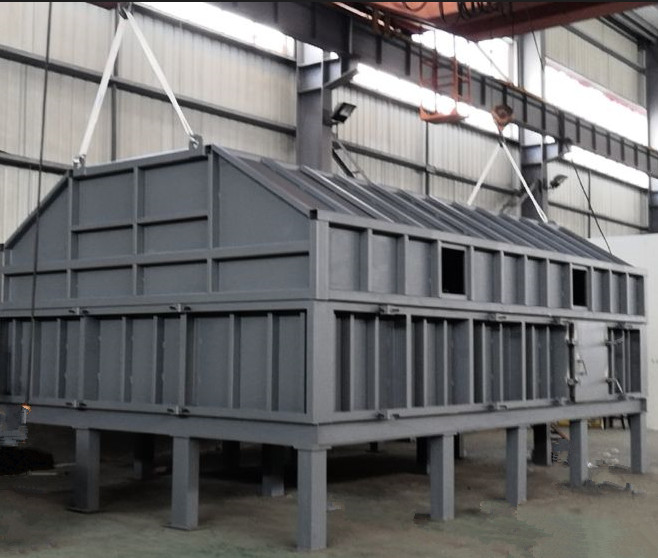Testing equipment for curtain wall doors

Through a large number of on-site curtain wall tests, our company has carried out optimization and innovative research and development of equipment, and at the same time of comprehensive performance of metal roofs, it has solved a large number of existing curtain walls and curtain walls in construction. (Sprinkler accessories are self-provided, and the equipment is responsible for differential pressure control), wind pressure resistance detection and in-plane deformation detection (optional, only suitable for new curtain walls on site).
The advanced control system is adopted in the control mode, including precise pressure regulation of pneumatic control valve, automatic control by microcomputer, display and record process control curve, printing of original records and multiple automatic control functions of test results. The overall design has many advantages, such as wide adaptability, easy operation, stable performance, high control precision, accurate data collection and low comprehensive noise.
- JGJ 255-2012 "Technical Specifications for Lighting Roof and Metal Roof" Appendix B
- Appendix C of GB 50205-2020 "Code for Acceptance of Construction Quality of Steel Structure Engineering"
- GB/T 31543-2015 "Test method for wind resistance of single-layer coiled roof system"
- GB/T 39794.1-2021 "Test method for wind resistance of metal roofs - Part 1"
- GB/T 39794.2-2021 "Test method for wind resistance of metal roofs - Part 2"
- JGJ/T324-2014 "Standards for Testing Methods of Building Curtain Wall Engineering" (compatible, need to be equipped with static pressure box, watertight nozzles and other accessories to assist)
- GB/T 15227-2019 "Test methods for airtightness, watertightness and wind pressure resistance of building curtain walls" (compatible, need to be equipped with static pressure box, watertight nozzles and other accessories on site)
1. Power system pressure supply device
1.1 Two independent high-speed centrifugal fans are used. The high-power centrifugal fans are respectively connected to the upper and lower static pressure boxes through pipelines, and the pipelines can be switched through valves; provide wind pressure during wind pressure test, pressure range: ±20000Pa ; The pipeline also reserves the interface to connect the small fan for common or separate test. The wind pressure is controlled by the frequency converter and the hydraulic system, and the minimum resolution for adjusting the wind pressure is 10Pa. When the equipment starts, it has no impact on the power grid, low noise and low vibration, and can save energy by 30-50%. The fan and inverter are assembled in a mobile steel structure container type, and the H-shaped steel is used, which has good rigidity and small deformation of the equipment itself under high pressure; integrated fan and control circuit, compact structure design; good sealing; overall steel structure box They are all treated with anti-rust, and high-quality primer and topcoat are used, and they are sprayed multiple times; the top adopts a hoisting structure for easy transportation, and the bottom costs a pressure-bearing suction cup mechanism to ensure stability during testing and transportation.
1.2 Electric servo control technology is adopted for the valve actuator in the device, the system has stable performance, high speed and high control precision, which fully meets the technical requirements of testing equipment. Ensure that the pressure of the system is stable and adjust quickly during detection, and provide the necessary test conditions for accurate detection.
1.3 The electrical system is designed with advanced butterfly valves to adjust the air flow and thus make the pressure difference between the inner and outer chambers accurately controlled. The air leakage of the test piece is measured and displayed in real time by the computer. The frequency converter and four-way valve mechanism are used to control the air supply power device to ensure that the pressure of the system is stable during the air permeability test. The system is equipped with a special air leakage valve. During the adjustment process, the air inlet and air outlet will not be completely closed, avoiding the occurrence of surge. The advantage of this method is that two fans provide positive and negative pressure to the static pressure box at the same time, and the frequency converter is used to adjust the fan frequency, which can save energy, reduce the starting current, and reduce the noise of fan operation; the pressure regulation accuracy is high, and the pressure adjustment The response speed is fast, the waveform is very symmetrical, and it is suitable for the needs of large-scale roof inspection.
1.4 Use domestic well-known brands of fans (Jizhong high-pressure centrifugal fans, the minimum accuracy of wind pressure is 1Pa, and the pressure formed by work is ≥20kPa), water pumps (Industrial Water Pump Co., Ltd.), reducers, displacement sensors, and wind speed sensors (imported from Austria EE75), differential pressure sensor, etc. to ensure product quality and maximize the stability of roof inspection equipment.
1.5 The low-power centrifugal fan is connected to the lower static pressure box to provide static pressure when measuring air leakage, pressure range: ±20000Pa; equipped with special airtight measuring pipe, pipe diameter: 100mm.
1.6 The equipment adopts a unique positive and negative pressure reversing device, the mechanism is flexible and reliable, and the positive pressure and negative pressure conversion of wind pressure can be realized.
2. Box structure device
2.1 The static pressure box is designed as a steel structure box with two box design, and the upper box is a movable box. The box profile adopts Q235 model, which has good rigidity and small deformation of the equipment itself under high pressure; compact structure design; good sealing performance; the overall steel structure box body is treated with anti-rust treatment, and high-quality primer and topcoat are used, and sprayed many times , to ensure the good compression resistance of the box, and a unique special door for airtight detection is designed on the side of the box to ensure accurate and reliable airtight detection;
2.2 For the connection between the movable static pressure box and the fixed air pressure pipeline, a detachable steel pipe is used;
2.3 Use a hose to connect the movable static pressure box and the fixed cable;
2.4 The equipment is equipped with a pressure fluctuation adjustment system on the mobile static pressure box, and an electric regulating butterfly valve (Φ400) is used in the pressure relief pipeline to adjust the lower limit of the fluctuating pressure. The pneumatic shut-off valve on the pipeline can be used to achieve fast closing and opening functions. Make the wind pressure fluctuation curve closer to the actual usage.
3. Data sensor acquisition device
3.1 The equipment is used to ensure the accuracy of the pressure data and the response speed of the transmitter under high pressure and low pressure in the wind pressure experiment. Six pressure transmitters with different ranges are used, which are:
1) Measure the pressure of the upper static pressure tank, 1 pressure transmitter;
2) Measure the pressure of the lower static pressure tank, 1 pressure transmitter;
3) Measure the outer surface and inner interlayer pressure of the test piece, 2 pressure transmitters;
4) Measuring airtight pressure: 1 pressure transmitter;
3.2 The equipment is designed to ensure the accuracy and stability of displacement measurement within a sufficiently large deformation range. Fifteen wireless displacement sensors are used, and 24-bit data acquisition equipment is reserved, which are:
1) 10 pieces of 0~50mm range;
2) 5 pieces of 0~100mm range;
3) The displacement adopts the self-developed wireless digital displacement sensor, the accuracy is within 0.2% of the full scale, and the magnetic meter seat is used for fixing, which is convenient, fast, firm, and easy to disassemble, which solves the problem of the line clutter in the test process of the traditional belt-line displacement meter ills.
4. Control and data acquisition, calculation and processing
4.1 The control system of the equipment mainly adopts the automatic control system (including the start of the fan, the start of the water pump, the opening and closing of the valve, etc.), and manual control can also be used. The two systems can be switched without interruption.
4.2 The two-level computer distributed monitoring system adopts industrial computer, board card and intelligent instrument, which can automatically control the detection process, automatically collect the detection data, generate and print the detection report, and have the function of historical data query. Data will not be lost after power failure.
4.3 The advanced data processing system can automatically analyze and process the test results, and output the test report timely and accurately.
4.4 Reports and original records are processed by Microsoft Word, and users can modify and make their formats by themselves. Professional report formats are attached to the software for users' reference.
4.5 The special software for measurement and control is used by senior inspection personnel using Windows8/10 platform, VB/VC mixed programming, and the convenient and flexible man-machine dialogue interface controls the entire inspection process.
4.6 Open Access database management, with strong compatibility, can be seamlessly connected with any management software interface.





